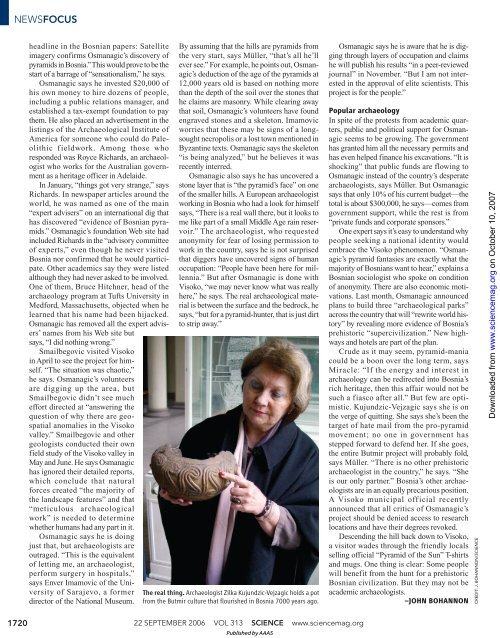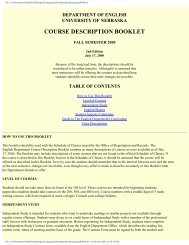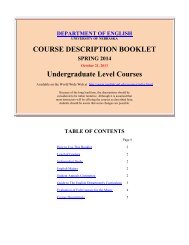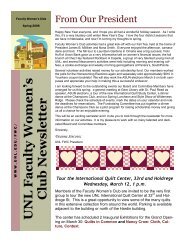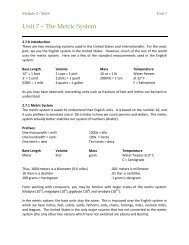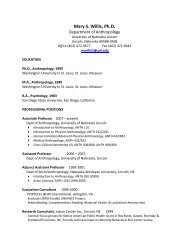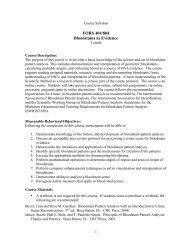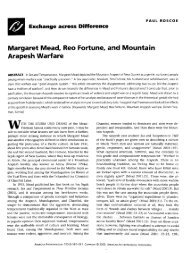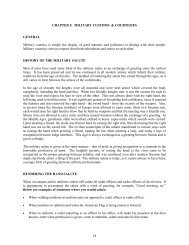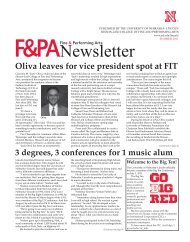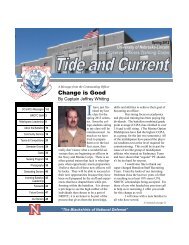Mad About Pyramids
Mad About Pyramids
Mad About Pyramids
You also want an ePaper? Increase the reach of your titles
YUMPU automatically turns print PDFs into web optimized ePapers that Google loves.
NEWSFOCUS<br />
1720<br />
headline in the Bosnian papers: Satellite<br />
imagery confirms Osmanagic’s discovery of<br />
pyramids in Bosnia.” This would prove to be the<br />
start of a barrage of “sensationalism,” he says.<br />
Osmanagic says he invested $20,000 of<br />
his own money to hire dozens of people,<br />
including a public relations manager, and<br />
established a tax-exempt foundation to pay<br />
them. He also placed an advertisement in the<br />
listings of the Archaeological Institute of<br />
America for someone who could do Paleolithic<br />
fieldwork. Among those who<br />
responded was Royce Richards, an archaeologist<br />
who works for the Australian government<br />
as a heritage officer in Adelaide.<br />
In January, “things got very strange,” says<br />
Richards. In newspaper articles around the<br />
world, he was named as one of the main<br />
“expert advisers” on an international dig that<br />
has discovered “evidence of Bosnian pyramids.”<br />
Osmanagic’s foundation Web site had<br />
included Richards in the “advisory committee<br />
of experts,” even though he never visited<br />
Bosnia nor confirmed that he would participate.<br />
Other academics say they were listed<br />
although they had never asked to be involved.<br />
One of them, Bruce Hitchner, head of the<br />
archaeology program at Tufts University in<br />
Medford, Massachusetts, objected when he<br />
learned that his name had been hijacked.<br />
Osmanagic has removed all the expert advisers’<br />
names from his Web site but<br />
says, “I did nothing wrong.”<br />
Smailbegovic visited Visoko<br />
in April to see the project for himself.<br />
“The situation was chaotic,”<br />
he says. Osmanagic’s volunteers<br />
are digging up the area, but<br />
Smailbegovic didn’t see much<br />
effort directed at “answering the<br />
question of why there are geospatial<br />
anomalies in the Visoko<br />
valley.” Smailbegovic and other<br />
geologists conducted their own<br />
field study of the Visoko valley in<br />
May and June. He says Osmanagic<br />
has ignored their detailed reports,<br />
which conclude that natural<br />
forces created “the majority of<br />
the landscape features” and that<br />
“meticulous archaeological<br />
work” is needed to determine<br />
whether humans had any part in it.<br />
Osmanagic says he is doing<br />
just that, but archaeologists are<br />
outraged. “This is the equivalent<br />
of letting me, an archaeologist,<br />
perform surgery in hospitals,”<br />
says Enver Imamovic of the University<br />
of Sarajevo, a former<br />
director of the National Museum.<br />
By assuming that the hills are pyramids from<br />
the very start, says Müller, “that’s all he’ll<br />
ever see.” For example, he points out, Osmanagic’s<br />
deduction of the age of the pyramids at<br />
12,000 years old is based on nothing more<br />
than the depth of the soil over the stones that<br />
he claims are masonry. While clearing away<br />
that soil, Osmanagic’s volunteers have found<br />
engraved stones and a skeleton. Imamovic<br />
worries that these may be signs of a longsought<br />
necropolis or a lost town mentioned in<br />
Byzantine texts. Osmanagic says the skeleton<br />
“is being analyzed,” but he believes it was<br />
recently interred.<br />
Osmanagic also says he has uncovered a<br />
stone layer that is “the pyramid’s face” on one<br />
of the smaller hills. A European archaeologist<br />
working in Bosnia who had a look for himself<br />
says, “There is a real wall there, but it looks to<br />
me like part of a small Middle Age rain reservoir.”<br />
The archaeologist, who requested<br />
anonymity for fear of losing permission to<br />
work in the country, says he is not surprised<br />
that diggers have uncovered signs of human<br />
occupation: “People have been here for millennia.”<br />
But after Osmanagic is done with<br />
Visoko, “we may never know what was really<br />
here,” he says. The real archaeological material<br />
is between the surface and the bedrock, he<br />
says, “but for a pyramid-hunter, that is just dirt<br />
to strip away.”<br />
The real thing. Archaeologist Zilka Kujundzic-Vejzagic holds a pot<br />
from the Butmir culture that flourished in Bosnia 7000 years ago.<br />
22 SEPTEMBER 2006 VOL 313 SCIENCE www.sciencemag.org<br />
Published by AAAS<br />
Osmanagic says he is aware that he is digging<br />
through layers of occupation and claims<br />
he will publish his results “in a peer-reviewed<br />
journal” in November. “But I am not interested<br />
in the approval of elite scientists. This<br />
project is for the people.”<br />
Popular archaeology<br />
In spite of the protests from academic quarters,<br />
public and political support for Osmanagic<br />
seems to be growing. The government<br />
has granted him all the necessary permits and<br />
has even helped finance his excavations. “It is<br />
shocking” that public funds are flowing to<br />
Osmanagic instead of the country’s desperate<br />
archaeologists, says Müller. But Osmanagic<br />
says that only 10% of his current budget—the<br />
total is about $300,000, he says—comes from<br />
government support, while the rest is from<br />
“private funds and corporate sponsors.”<br />
One expert says it’s easy to understand why<br />
people seeking a national identity would<br />
embrace the Visoko phenomenon. “Osmanagic’s<br />
pyramid fantasies are exactly what the<br />
majority of Bosnians want to hear,” explains a<br />
Bosnian sociologist who spoke on condition<br />
of anonymity. There are also economic motivations.<br />
Last month, Osmanagic announced<br />
plans to build three “archaeological parks”<br />
across the country that will “rewrite world history”<br />
by revealing more evidence of Bosnia’s<br />
prehistoric “supercivilization.” New highways<br />
and hotels are part of the plan.<br />
Crude as it may seem, pyramid-mania<br />
could be a boon over the long term, says<br />
Miracle: “If the energy and interest in<br />
archaeology can be redirected into Bosnia’s<br />
rich heritage, then this affair would not be<br />
such a fiasco after all.” But few are optimistic.<br />
Kujundzic-Vejzagic says she is on<br />
the verge of quitting. She says she’s been the<br />
target of hate mail from the pro-pyramid<br />
movement; no one in government has<br />
stepped forward to defend her. If she goes,<br />
the entire Butmir project will probably fold,<br />
says Müller. “There is no other prehistoric<br />
archaeologist in the country,” he says. “She<br />
is our only partner.” Bosnia’s other archaeologists<br />
are in an equally precarious position.<br />
A Visoko municipal official recently<br />
announced that all critics of Osmanagic’s<br />
project should be denied access to research<br />
locations and have their degrees revoked.<br />
Descending the hill back down to Visoko,<br />
a visitor wades through the friendly locals<br />
selling official “Pyramid of the Sun” T-shirts<br />
and mugs. One thing is clear: Some people<br />
will benefit from the hunt for a prehistoric<br />
Bosnian civilization. But they may not be<br />
academic archaeologists.<br />
–JOHN BOHANNON<br />
CREDIT: J. BOHANNON/SCIENCE<br />
on October 10, 2007<br />
www.sciencemag.org<br />
Downloaded from


